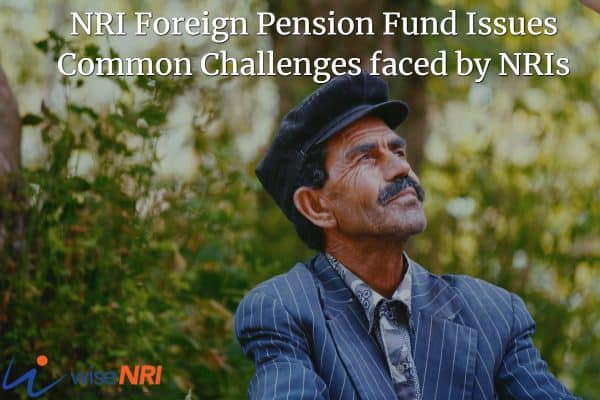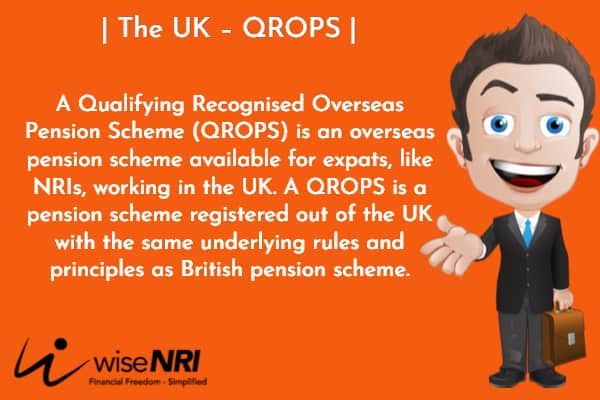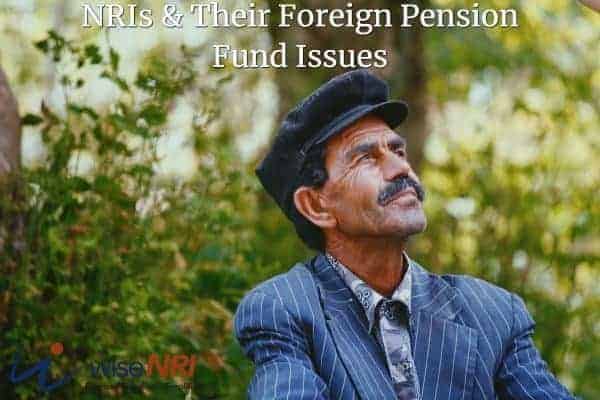Many NRIs, who have gone for work to developed countries, have over the years build a substantial provident or pension fund for themselves. In many countries, employers are required to contribute to this retirement fund as part of their packages.

Must Read – Pension Plan For NRI in India – Dream Retirement
As many Indian cities, today have world-class facilities, at a fraction of the cost, most Indians prefer to spend their retirements here to take advantage of the currency and cost arbitrage. The problem comes when NRIs have to get their hard-earned pension funds transferred to India.
We discuss key issues with the transfer of pension funds from four countries from where many NRIs return to India.
NRI Foreign Pension Fund Issues: Common Issues faced by NRIs
- What is the US 401K plan for NRI?
- NRIs facing issues while transferring The US 401K Funds to India.
- NRIs facing issues while Transferring Singapore CPF Funds to India.
- What is the UK QROPS for NRI?
- What Kind of Problem do NRIs are facing while transferring UK QROPS Funds to India?
- What is Australia Superannuation Plan for NRI?
- What Kind of Problem is NRI facing while transferring Australia – Superannuation funds to India?
US 401k retirement Plans For NRIs
As discussed in the article NRIs and All they need to know about the US 401k retirement Plans, The USA has three different retirement funds available to NRIs: the 401(k) USA, Traditional IRA, and Roth IRA/401(k).
Retirement plan 401k USA for NRI
Offered by the employer, 401(k) is a defined contribution plan where they match your contributions. As contributions are made before paying taxes, therefore, the entire corpus is taxable at withdrawal at prevailing rates.
Traditional IRA
It is a self-sustained retirement plan with only your contributions. Usually, professionals or business owners open a new IRA account or when a salaried person leaves their job, they can roll over 401(k) USA into a Traditional IRA account. Again, as contributions are made pre-tax, the tax is deferred until withdrawals.
Roth IRA/401(k)
To make investments from post-tax income, so that there is NO tax liability at the time of withdrawal, the Roth IRA is the best option. Withdrawal of principal is tax-free; however, any earnings are taxable at prevailing rates, which is still very efficient. Nor does early withdrawals attract taxes or penalties like in the case of the 401(k) plan the USA. If you withdraw after five years or turning 59½, then earnings are also tax-free.
Read More – US 401k retirement Plans
Singapore CPF
The Singapore Central Provident Fund (CPF) is a very progressive pension scheme for NRIs who are called Singapore Permanent Residents (SPRs). The CPF Pension scheme is a mandatory savings scheme with defined contributions from both the employees and employers at pre-defined rates. The contribution to the fund varies as per the age group to which the employee belongs.
The Singapore cpf contributions are allocated into three special accounts, to meet different long-term life goals:
- Ordinary Account (OA) – for corpus for housing, insurance, investments, and educational expenses.
- Special Account (SA) – for investments in retirement-related financial products.
- Medisave Account (MA) – for payment for approved medical insurance and hospitalization expenses.
There is a Retirement Account (RA), which is not a separate account but created by merging OA and SA when you turn 55. It works like an annuity from which monthly payouts are made to seniors to meet basic needs.
If you are returning back to India, you must first settle all your tax liabilities to get the Singapore IRAS tax clearance. After that, you can apply for the complete withdrawal of your CPF balances from all three accounts in full.
The CPF Board will inform the agent bank or product provider managing your CPF Investment Scheme in OA or SA, respectively. They can approach the bank/provider and they will transfer your assets to your account that you may liquidate.
Must Read – Singapore Central Provident Fund
The UK – QROPS For NRIs
A Qualifying Recognised Overseas Pension Scheme (QROPS) is an overseas pension scheme available for expats, like NRIs, working in the UK. A trust or fund must meet certain requirements set by Her Majesty’s Revenue and Customs (HMRC) so that it can receive transfers of British pension benefits.

Must Read – Mr. NRI – How Much Retirement Corpus Is Enough
A UK QROPS is a pension scheme registered out of the UK with the same underlying rules and principles as British pension schemes.
An NRI with benefits in the UK can move their pension to India via a QROPS, set up in India or a third country, and have the benefits paid here. Job-hopping NRIs can transfer multiple pensions into one online, low-cost, and transparent structure. QROPS trusts allow them multiple investment avenues and offer flexibility in the withdrawal limit at retirement.
To get recognized under the UK QROPS, a scheme must:
- be established in India, a country within the EU, Norway, Liechtenstein, Iceland, and the United States.
- be established in a country having DTAA with the UK with the exchange of information and non-discrimination provisions.
- satisfy following requirements at the time of the recognized transfer:
- At least 70% of the transferred funds will be used as a corpus for a life-long annuity.
- The pension and associated lump-sum benefits would be payable as per retirement rules applicable in the UK.
- The pension scheme is open for all persons in the country of its establishment.
A QROPS for NRI offers the flexibility to the members to choose investment options, investment currency, lump-sum/pension withdrawal at retirement.
Although a UK QROPS plan is significantly more expensive than a SIPP, but for NRIs, it is the option if they want to retire in India. If the UK QROPS is set up by an Indian entity, then the overseas tax charge of 25% will not be applicable.
Therefore, NRIs working in the UK, who have built up significant pension benefits, can opt QROPS to:
- Transfer their savings to India, in a tax-efficient retirement product.
- Offers steady life-long post-retirement pension in India.
- Allows multiple avenues for growth in India.
Australia – Superannuation Plan For NRIs
According to the Federal laws of Australia, Superannuation, or simply super, is a mandatory defined contribution provident fund scheme for working people in Australia. The super is used to provide a life-long income stream to retirees.
Rules dictate Superannuation Guarantee (SG) or the minimum contribution, at 9.5%, from employers to the super accounts of their employees, in addition to the standard salaries. The Australian government gives limited tax incentives to individuals who invest in their Superannuation accounts.
If you are holding multiple Superannuation accounts, then it is difficult to consolidate them. But you can always port your funds with preservation until either you retire or satisfy a condition of early release.
According to applicable rules, one can withdraw funds on the following conditions: retirement, terminal medical illness, permanent disability, or buying their first home.
If you are returning to India, you must lodge an Australian tax return early or online. The treatment of your superannuation depends on if you were a Permanent resident (PR) or a temporary resident (TR) in Australia.
Read – Retirement planning India for NRI
Permanent Residents
If you were a PR, then your super account will remain subject to the same rules, as if you were still in Australia. You won’t be able to access your balance, in most cases, until you reach preservation age (55 to 60 years). The only exceptions are if you have become permanently disabled, are facing severe financial hardship, or a terminal medical condition.
Temporary Residents
If you were a TR, you may claim a Departing Australia Superannuation Fund Payment (DASP). To be eligible for a DASP, the following must apply:
- You must not be an Australian or New Zealand citizen, or a PR of Australia.
- You entered the country on a temporary visa (except in subclasses 405 or 410).
- You have departed Australia.
- Your Australian visa is no longer valid.
You must claim your super directly from the fund within six months of leaving Australia. If it has been longer, then the funds are transferred to the Australian Taxation Office (ATO), from where you must claim your balance.
You can fill the DASP application online anytime and save it but submit it only after you have departed Australia and your visa is inactive or canceled.
You must have the following documents ready before filling out the application:
- Passport number
- Australian Tax File Number (TFN)
- Details for each super fund including their Australian Business Number (ABN)
- Your Indian bank account’s details
- Certified copy of cancelled visa or evidence that you were a temporary resident.
- Certified copy of your passport page showing your ID and departure stamp.
- Confirmation of your application to cancel your temporary resident visa in Form 1194.
Taxation of DASP
Australia superannuation lump-sum tax is not applicable on DASP, but it is subject to a final withholding tax. Your super fund will deduct this tax. A DASP is neither your assessable income nor exempt income. If you have already paid the DASP withholding tax, then your lump-sum balance transfer may be tax-free in India.
If you would like to discuss your financial life – schedule a call
Note – please talk to your CA or Financial Planner before taking any action.
If you have any experience with NRI Foreign Pension Fund transfer issues or questions related to the transfer of pension funds to India – add them in the comment section.


which is the best QROPS scheme i can transfer my NHS pension to In India
Plz advise about retired from Middle East at the age 70 plus
Best regards
Need to know provisions for repatriation of pension received from public sector undertaking